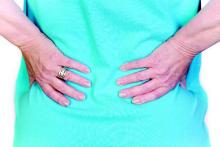NATIONAL HARBOR, MD. – Numerous recent studies link chronic pain, especially lower back pain, to obesity, Dr. Brian White said during a presentation at the annual meeting of the American Academy of Pain.
Many of these studies also indicate that weight loss can be an effective – and considerably more affordable – solution than drugs and surgery for relieving chronic pain. As pain can initially limit exercise, Dr. White, an interventional physiatrist with the Bassett Healthcare Network in Cooperstown, N.Y., advised starting patients on common-sense weight loss approaches, such as limiting intake of sugar and related products, particularly soda.
Studies linking obesity and pain include work at the Mayo Clinic (Pain. 2010;151[2];366-71) that identified obesity as one of the most common modifiable risk factors for pain management in older adults.
Further, another study (BMC Musculoskelet Disord. 2013;14:238) showed that overweight or obese individuals were more likely to report musculoskeletal pain, and that the frequency of complaints increased as subjects’ weights increased.
In a study involving adolescents with pain, (Pain. 2012;153[9]:1932-8), obese adolescents had a 1.33 odds ratio (OR) of having any kind of pain, a 2.04 OR for chronic regional pain, and a 1.87 OR for knee pain specifically (P less than .05), compared with normal-weight adolescents.
In a study of chronic pain in the elderly (Pain. 2011;152[1]:53-9), individuals with abdominal obesity had a higher risk for chronic lumbar pain (OR = 2.25); upper extremity pain (OR = 2.01); and pain in either the hip, knee, or any lower extremity (OR = 1.86; P less than 0.05 for all pain locations), compared with normal-weight elderly individuals. Women were more likely to experience chronic pain (OR = 1.81, P less than 0.05). The findings were “independent of other components of metabolic syndrome, hsCRP, insulin resistance, depression, anxiety, and the presence of painful comorbid conditions,” the study concluded.
An Australian study (Eur J Pain. 2013;17(7):957-71) that reviewed low back pain studies in twins found that obesity was an indicator (OR = 1.9) and that “both obesity and smoking demonstrated dose-dependant relationships with lower back pain,” said Dr. White.
The HUNT 2 study from Norway (Spine. 2010;35(7):764-8) evaluated nearly 64,000 men and women over a 2-year period and found that the odds ratio for lower back pain increased by 1.07 in men and by 1.17 in women for every 5-point gain in body mass index. Study participants with a BMI greater than 30 at baseline were more likely to develop low back pain than were those with a baseline BMI under 25.
Dr. White did not report any relevant financial disclosures.


